University Assignment: Managing Workplace Diversity Report
VerifiedAdded on 2021/06/17
|7
|1396
|31
Report
AI Summary
This report comprehensively examines the multifaceted aspects of managing workplace diversity, focusing on key anti-discrimination acts and the development of effective harassment policies. The report begins by outlining the Age Discrimination Act, Disability Discrimination Act, Racial Discrimination Act, Sex Discrimination Act, and the Australian Human Rights Commission Act, detailing the core principles, requirements, and complaint processes associated with each. It highlights the importance of these acts in ensuring equal treatment and opportunities for all individuals, irrespective of age, disability, race, or sex. Furthermore, the report emphasizes the need for a robust bullying/harassment policy to create a safe and healthy work environment. It outlines the essential components of such a policy, including formal and informal procedures for addressing complaints, ensuring confidentiality, and promoting fairness. The report underscores the critical role of organizational strategies, such as education, training, and regular assessments, in the successful implementation of these policies to foster a diverse, inclusive, and respectful workplace.
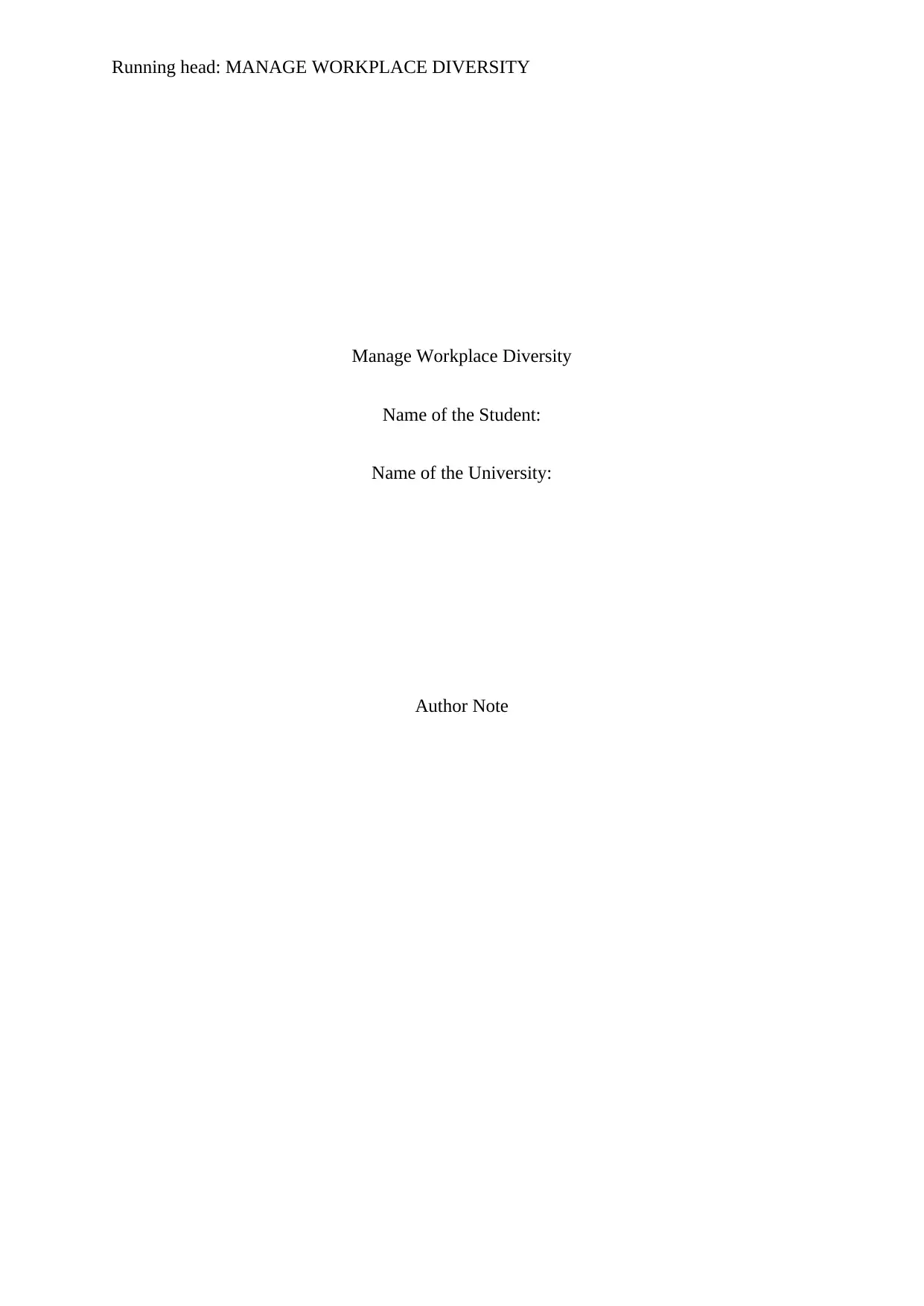
Running head: MANAGE WORKPLACE DIVERSITY
Manage Workplace Diversity
Name of the Student:
Name of the University:
Author Note
Manage Workplace Diversity
Name of the Student:
Name of the University:
Author Note
Paraphrase This Document
Need a fresh take? Get an instant paraphrase of this document with our AI Paraphraser
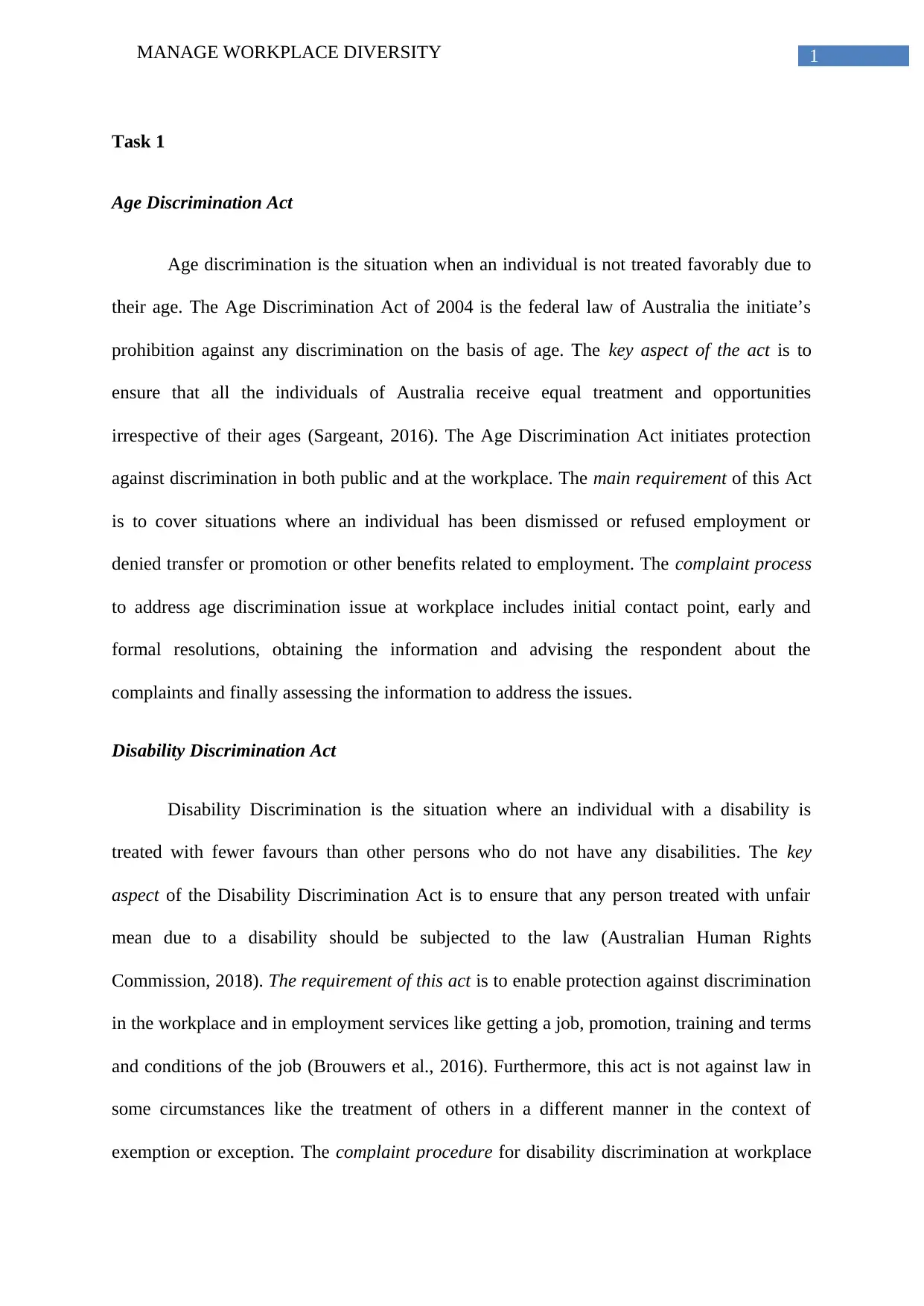
1MANAGE WORKPLACE DIVERSITY
Task 1
Age Discrimination Act
Age discrimination is the situation when an individual is not treated favorably due to
their age. The Age Discrimination Act of 2004 is the federal law of Australia the initiate’s
prohibition against any discrimination on the basis of age. The key aspect of the act is to
ensure that all the individuals of Australia receive equal treatment and opportunities
irrespective of their ages (Sargeant, 2016). The Age Discrimination Act initiates protection
against discrimination in both public and at the workplace. The main requirement of this Act
is to cover situations where an individual has been dismissed or refused employment or
denied transfer or promotion or other benefits related to employment. The complaint process
to address age discrimination issue at workplace includes initial contact point, early and
formal resolutions, obtaining the information and advising the respondent about the
complaints and finally assessing the information to address the issues.
Disability Discrimination Act
Disability Discrimination is the situation where an individual with a disability is
treated with fewer favours than other persons who do not have any disabilities. The key
aspect of the Disability Discrimination Act is to ensure that any person treated with unfair
mean due to a disability should be subjected to the law (Australian Human Rights
Commission, 2018). The requirement of this act is to enable protection against discrimination
in the workplace and in employment services like getting a job, promotion, training and terms
and conditions of the job (Brouwers et al., 2016). Furthermore, this act is not against law in
some circumstances like the treatment of others in a different manner in the context of
exemption or exception. The complaint procedure for disability discrimination at workplace
Task 1
Age Discrimination Act
Age discrimination is the situation when an individual is not treated favorably due to
their age. The Age Discrimination Act of 2004 is the federal law of Australia the initiate’s
prohibition against any discrimination on the basis of age. The key aspect of the act is to
ensure that all the individuals of Australia receive equal treatment and opportunities
irrespective of their ages (Sargeant, 2016). The Age Discrimination Act initiates protection
against discrimination in both public and at the workplace. The main requirement of this Act
is to cover situations where an individual has been dismissed or refused employment or
denied transfer or promotion or other benefits related to employment. The complaint process
to address age discrimination issue at workplace includes initial contact point, early and
formal resolutions, obtaining the information and advising the respondent about the
complaints and finally assessing the information to address the issues.
Disability Discrimination Act
Disability Discrimination is the situation where an individual with a disability is
treated with fewer favours than other persons who do not have any disabilities. The key
aspect of the Disability Discrimination Act is to ensure that any person treated with unfair
mean due to a disability should be subjected to the law (Australian Human Rights
Commission, 2018). The requirement of this act is to enable protection against discrimination
in the workplace and in employment services like getting a job, promotion, training and terms
and conditions of the job (Brouwers et al., 2016). Furthermore, this act is not against law in
some circumstances like the treatment of others in a different manner in the context of
exemption or exception. The complaint procedure for disability discrimination at workplace
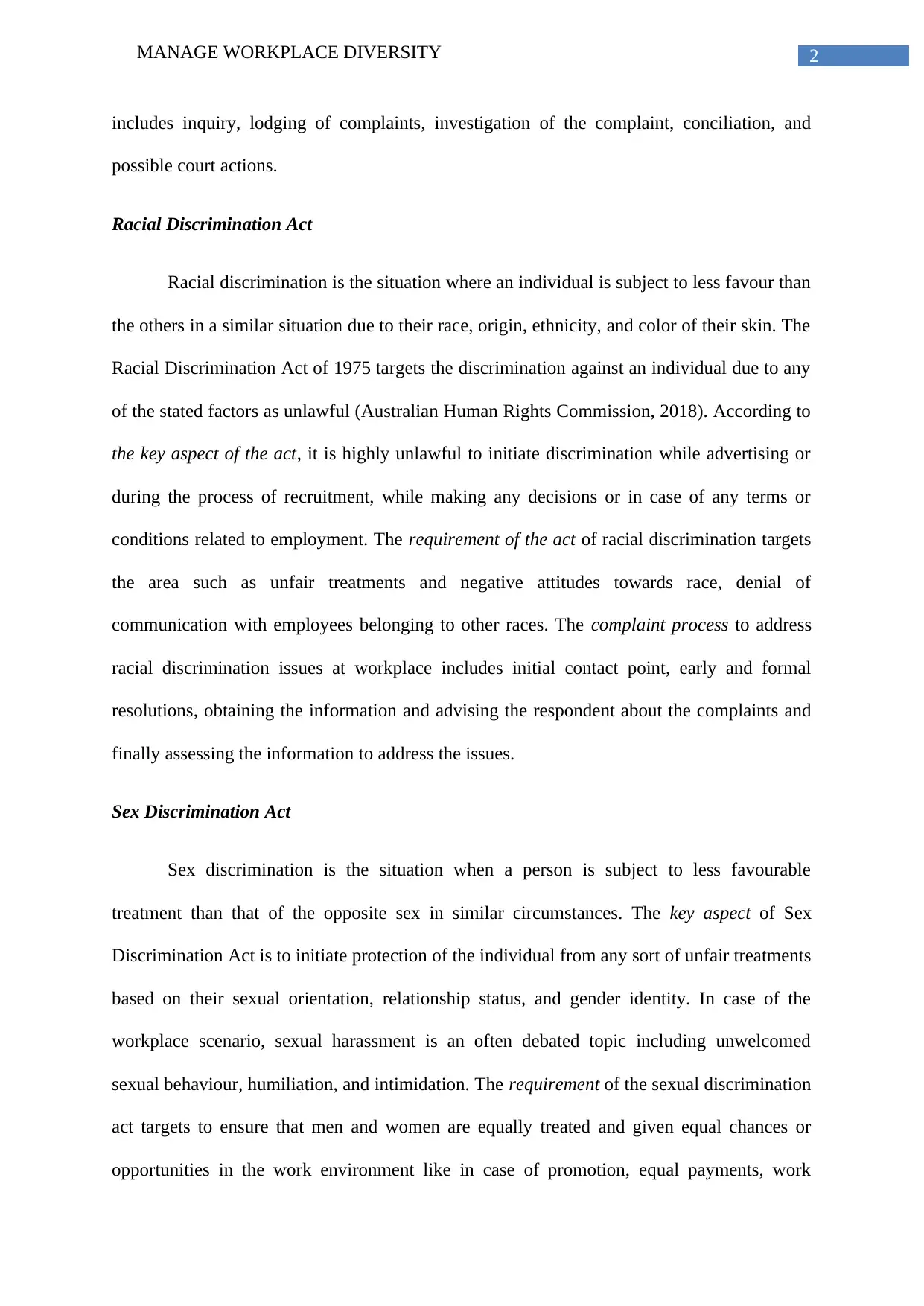
2MANAGE WORKPLACE DIVERSITY
includes inquiry, lodging of complaints, investigation of the complaint, conciliation, and
possible court actions.
Racial Discrimination Act
Racial discrimination is the situation where an individual is subject to less favour than
the others in a similar situation due to their race, origin, ethnicity, and color of their skin. The
Racial Discrimination Act of 1975 targets the discrimination against an individual due to any
of the stated factors as unlawful (Australian Human Rights Commission, 2018). According to
the key aspect of the act, it is highly unlawful to initiate discrimination while advertising or
during the process of recruitment, while making any decisions or in case of any terms or
conditions related to employment. The requirement of the act of racial discrimination targets
the area such as unfair treatments and negative attitudes towards race, denial of
communication with employees belonging to other races. The complaint process to address
racial discrimination issues at workplace includes initial contact point, early and formal
resolutions, obtaining the information and advising the respondent about the complaints and
finally assessing the information to address the issues.
Sex Discrimination Act
Sex discrimination is the situation when a person is subject to less favourable
treatment than that of the opposite sex in similar circumstances. The key aspect of Sex
Discrimination Act is to initiate protection of the individual from any sort of unfair treatments
based on their sexual orientation, relationship status, and gender identity. In case of the
workplace scenario, sexual harassment is an often debated topic including unwelcomed
sexual behaviour, humiliation, and intimidation. The requirement of the sexual discrimination
act targets to ensure that men and women are equally treated and given equal chances or
opportunities in the work environment like in case of promotion, equal payments, work
includes inquiry, lodging of complaints, investigation of the complaint, conciliation, and
possible court actions.
Racial Discrimination Act
Racial discrimination is the situation where an individual is subject to less favour than
the others in a similar situation due to their race, origin, ethnicity, and color of their skin. The
Racial Discrimination Act of 1975 targets the discrimination against an individual due to any
of the stated factors as unlawful (Australian Human Rights Commission, 2018). According to
the key aspect of the act, it is highly unlawful to initiate discrimination while advertising or
during the process of recruitment, while making any decisions or in case of any terms or
conditions related to employment. The requirement of the act of racial discrimination targets
the area such as unfair treatments and negative attitudes towards race, denial of
communication with employees belonging to other races. The complaint process to address
racial discrimination issues at workplace includes initial contact point, early and formal
resolutions, obtaining the information and advising the respondent about the complaints and
finally assessing the information to address the issues.
Sex Discrimination Act
Sex discrimination is the situation when a person is subject to less favourable
treatment than that of the opposite sex in similar circumstances. The key aspect of Sex
Discrimination Act is to initiate protection of the individual from any sort of unfair treatments
based on their sexual orientation, relationship status, and gender identity. In case of the
workplace scenario, sexual harassment is an often debated topic including unwelcomed
sexual behaviour, humiliation, and intimidation. The requirement of the sexual discrimination
act targets to ensure that men and women are equally treated and given equal chances or
opportunities in the work environment like in case of promotion, equal payments, work
⊘ This is a preview!⊘
Do you want full access?
Subscribe today to unlock all pages.

Trusted by 1+ million students worldwide
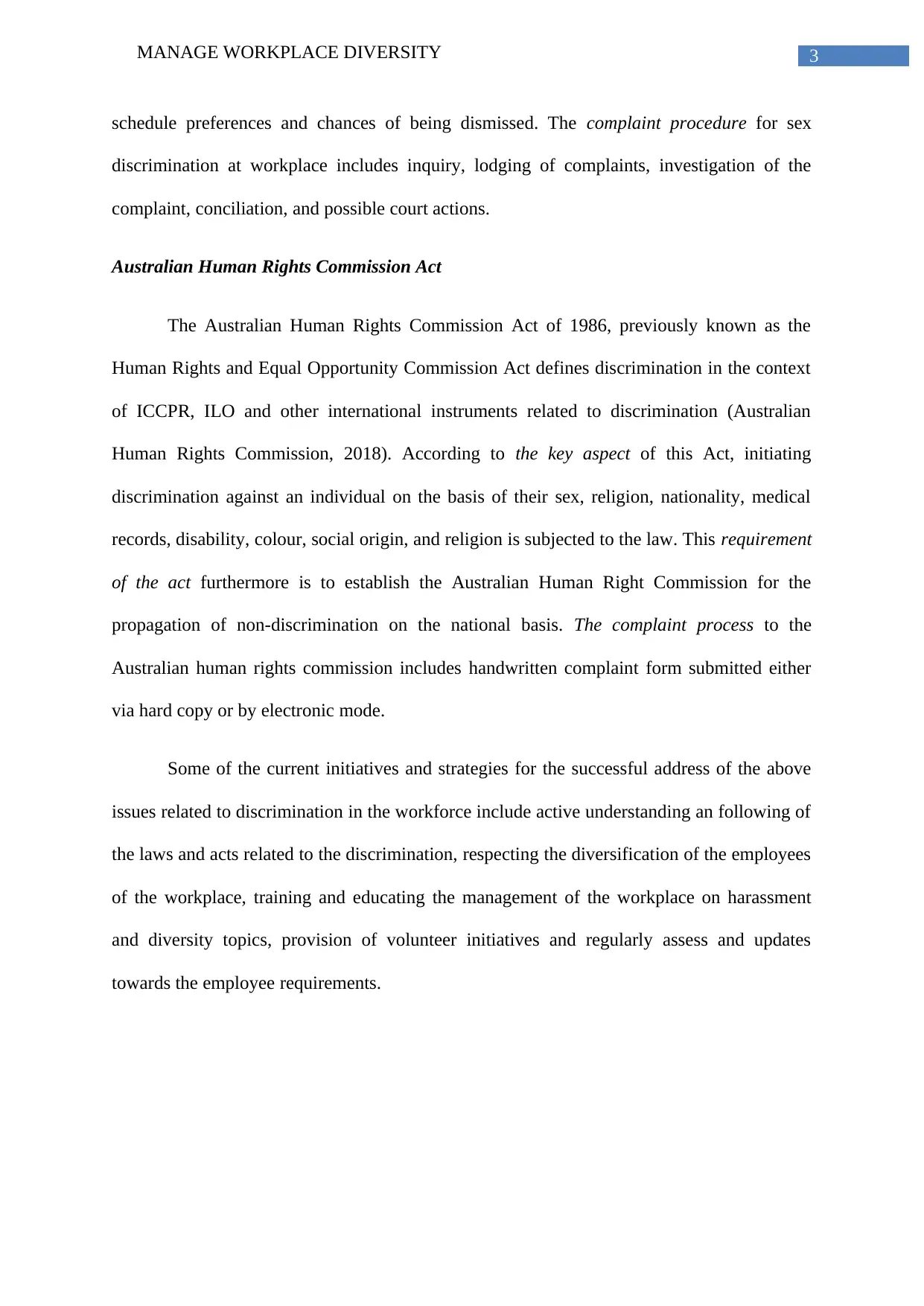
3MANAGE WORKPLACE DIVERSITY
schedule preferences and chances of being dismissed. The complaint procedure for sex
discrimination at workplace includes inquiry, lodging of complaints, investigation of the
complaint, conciliation, and possible court actions.
Australian Human Rights Commission Act
The Australian Human Rights Commission Act of 1986, previously known as the
Human Rights and Equal Opportunity Commission Act defines discrimination in the context
of ICCPR, ILO and other international instruments related to discrimination (Australian
Human Rights Commission, 2018). According to the key aspect of this Act, initiating
discrimination against an individual on the basis of their sex, religion, nationality, medical
records, disability, colour, social origin, and religion is subjected to the law. This requirement
of the act furthermore is to establish the Australian Human Right Commission for the
propagation of non-discrimination on the national basis. The complaint process to the
Australian human rights commission includes handwritten complaint form submitted either
via hard copy or by electronic mode.
Some of the current initiatives and strategies for the successful address of the above
issues related to discrimination in the workforce include active understanding an following of
the laws and acts related to the discrimination, respecting the diversification of the employees
of the workplace, training and educating the management of the workplace on harassment
and diversity topics, provision of volunteer initiatives and regularly assess and updates
towards the employee requirements.
schedule preferences and chances of being dismissed. The complaint procedure for sex
discrimination at workplace includes inquiry, lodging of complaints, investigation of the
complaint, conciliation, and possible court actions.
Australian Human Rights Commission Act
The Australian Human Rights Commission Act of 1986, previously known as the
Human Rights and Equal Opportunity Commission Act defines discrimination in the context
of ICCPR, ILO and other international instruments related to discrimination (Australian
Human Rights Commission, 2018). According to the key aspect of this Act, initiating
discrimination against an individual on the basis of their sex, religion, nationality, medical
records, disability, colour, social origin, and religion is subjected to the law. This requirement
of the act furthermore is to establish the Australian Human Right Commission for the
propagation of non-discrimination on the national basis. The complaint process to the
Australian human rights commission includes handwritten complaint form submitted either
via hard copy or by electronic mode.
Some of the current initiatives and strategies for the successful address of the above
issues related to discrimination in the workforce include active understanding an following of
the laws and acts related to the discrimination, respecting the diversification of the employees
of the workplace, training and educating the management of the workplace on harassment
and diversity topics, provision of volunteer initiatives and regularly assess and updates
towards the employee requirements.
Paraphrase This Document
Need a fresh take? Get an instant paraphrase of this document with our AI Paraphraser
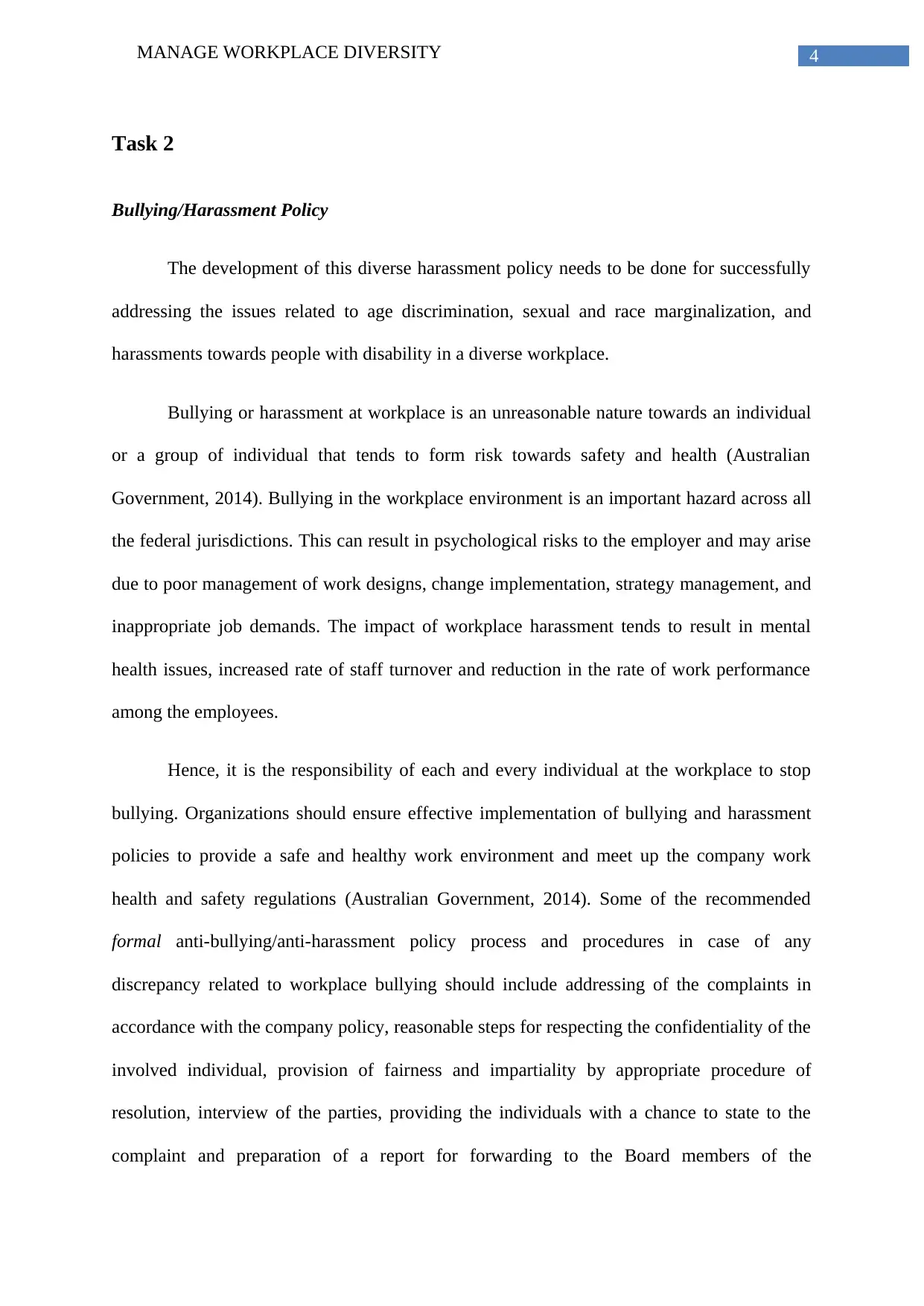
4MANAGE WORKPLACE DIVERSITY
Task 2
Bullying/Harassment Policy
The development of this diverse harassment policy needs to be done for successfully
addressing the issues related to age discrimination, sexual and race marginalization, and
harassments towards people with disability in a diverse workplace.
Bullying or harassment at workplace is an unreasonable nature towards an individual
or a group of individual that tends to form risk towards safety and health (Australian
Government, 2014). Bullying in the workplace environment is an important hazard across all
the federal jurisdictions. This can result in psychological risks to the employer and may arise
due to poor management of work designs, change implementation, strategy management, and
inappropriate job demands. The impact of workplace harassment tends to result in mental
health issues, increased rate of staff turnover and reduction in the rate of work performance
among the employees.
Hence, it is the responsibility of each and every individual at the workplace to stop
bullying. Organizations should ensure effective implementation of bullying and harassment
policies to provide a safe and healthy work environment and meet up the company work
health and safety regulations (Australian Government, 2014). Some of the recommended
formal anti-bullying/anti-harassment policy process and procedures in case of any
discrepancy related to workplace bullying should include addressing of the complaints in
accordance with the company policy, reasonable steps for respecting the confidentiality of the
involved individual, provision of fairness and impartiality by appropriate procedure of
resolution, interview of the parties, providing the individuals with a chance to state to the
complaint and preparation of a report for forwarding to the Board members of the
Task 2
Bullying/Harassment Policy
The development of this diverse harassment policy needs to be done for successfully
addressing the issues related to age discrimination, sexual and race marginalization, and
harassments towards people with disability in a diverse workplace.
Bullying or harassment at workplace is an unreasonable nature towards an individual
or a group of individual that tends to form risk towards safety and health (Australian
Government, 2014). Bullying in the workplace environment is an important hazard across all
the federal jurisdictions. This can result in psychological risks to the employer and may arise
due to poor management of work designs, change implementation, strategy management, and
inappropriate job demands. The impact of workplace harassment tends to result in mental
health issues, increased rate of staff turnover and reduction in the rate of work performance
among the employees.
Hence, it is the responsibility of each and every individual at the workplace to stop
bullying. Organizations should ensure effective implementation of bullying and harassment
policies to provide a safe and healthy work environment and meet up the company work
health and safety regulations (Australian Government, 2014). Some of the recommended
formal anti-bullying/anti-harassment policy process and procedures in case of any
discrepancy related to workplace bullying should include addressing of the complaints in
accordance with the company policy, reasonable steps for respecting the confidentiality of the
involved individual, provision of fairness and impartiality by appropriate procedure of
resolution, interview of the parties, providing the individuals with a chance to state to the
complaint and preparation of a report for forwarding to the Board members of the
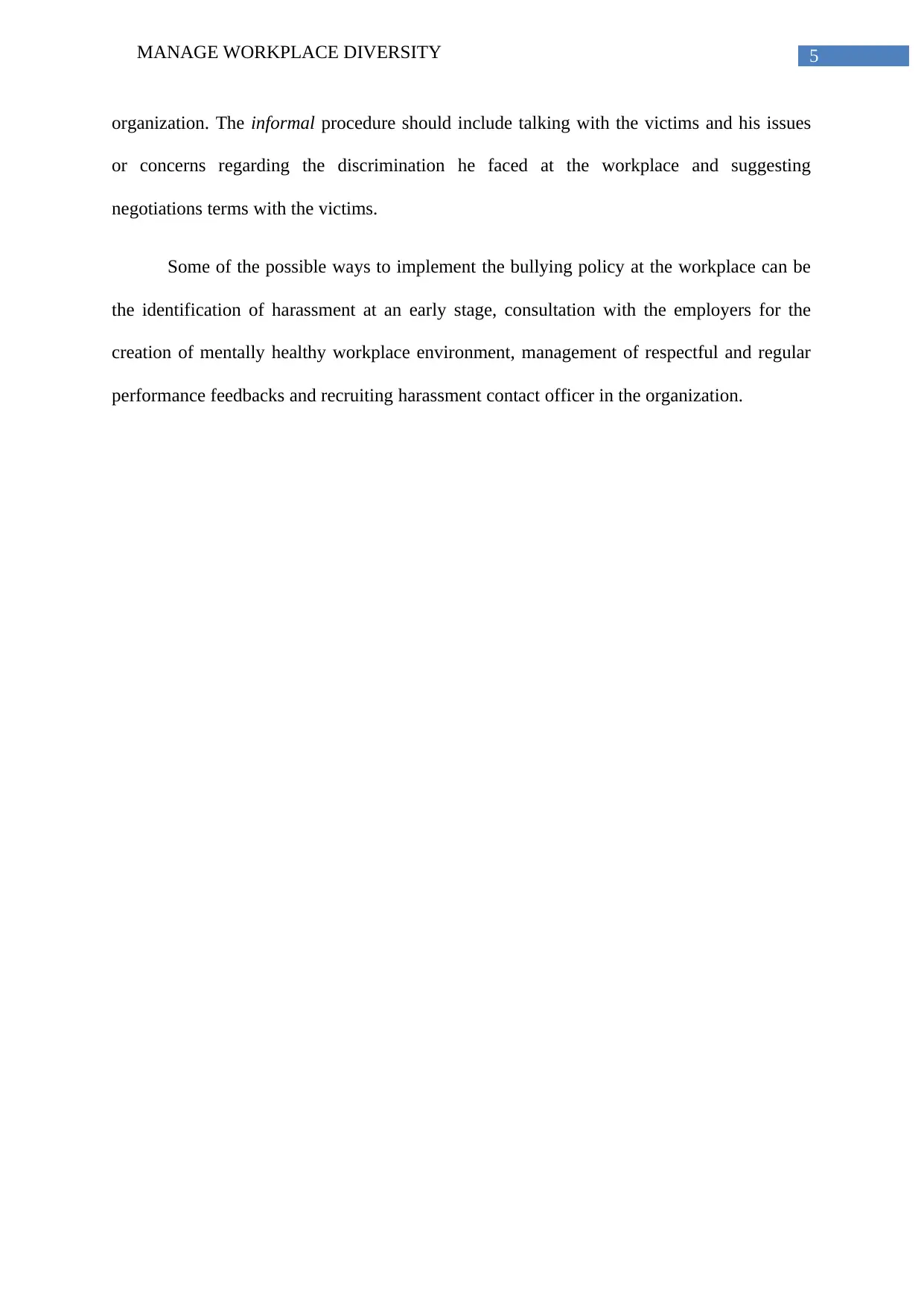
5MANAGE WORKPLACE DIVERSITY
organization. The informal procedure should include talking with the victims and his issues
or concerns regarding the discrimination he faced at the workplace and suggesting
negotiations terms with the victims.
Some of the possible ways to implement the bullying policy at the workplace can be
the identification of harassment at an early stage, consultation with the employers for the
creation of mentally healthy workplace environment, management of respectful and regular
performance feedbacks and recruiting harassment contact officer in the organization.
organization. The informal procedure should include talking with the victims and his issues
or concerns regarding the discrimination he faced at the workplace and suggesting
negotiations terms with the victims.
Some of the possible ways to implement the bullying policy at the workplace can be
the identification of harassment at an early stage, consultation with the employers for the
creation of mentally healthy workplace environment, management of respectful and regular
performance feedbacks and recruiting harassment contact officer in the organization.
⊘ This is a preview!⊘
Do you want full access?
Subscribe today to unlock all pages.

Trusted by 1+ million students worldwide
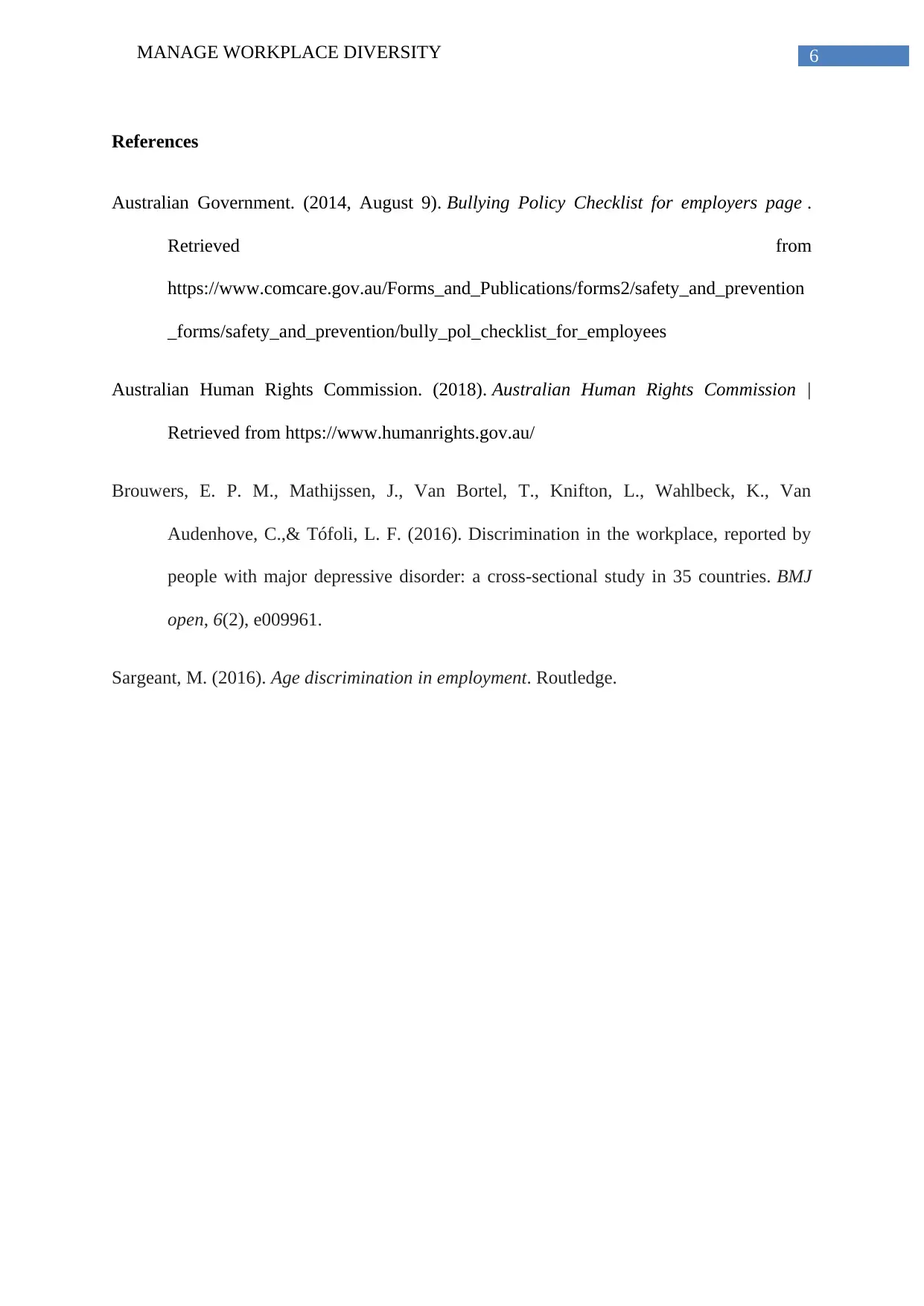
6MANAGE WORKPLACE DIVERSITY
References
Australian Government. (2014, August 9). Bullying Policy Checklist for employers page .
Retrieved from
https://www.comcare.gov.au/Forms_and_Publications/forms2/safety_and_prevention
_forms/safety_and_prevention/bully_pol_checklist_for_employees
Australian Human Rights Commission. (2018). Australian Human Rights Commission |
Retrieved from https://www.humanrights.gov.au/
Brouwers, E. P. M., Mathijssen, J., Van Bortel, T., Knifton, L., Wahlbeck, K., Van
Audenhove, C.,& Tófoli, L. F. (2016). Discrimination in the workplace, reported by
people with major depressive disorder: a cross-sectional study in 35 countries. BMJ
open, 6(2), e009961.
Sargeant, M. (2016). Age discrimination in employment. Routledge.
References
Australian Government. (2014, August 9). Bullying Policy Checklist for employers page .
Retrieved from
https://www.comcare.gov.au/Forms_and_Publications/forms2/safety_and_prevention
_forms/safety_and_prevention/bully_pol_checklist_for_employees
Australian Human Rights Commission. (2018). Australian Human Rights Commission |
Retrieved from https://www.humanrights.gov.au/
Brouwers, E. P. M., Mathijssen, J., Van Bortel, T., Knifton, L., Wahlbeck, K., Van
Audenhove, C.,& Tófoli, L. F. (2016). Discrimination in the workplace, reported by
people with major depressive disorder: a cross-sectional study in 35 countries. BMJ
open, 6(2), e009961.
Sargeant, M. (2016). Age discrimination in employment. Routledge.
1 out of 7
Related Documents
Your All-in-One AI-Powered Toolkit for Academic Success.
+13062052269
info@desklib.com
Available 24*7 on WhatsApp / Email
![[object Object]](/_next/static/media/star-bottom.7253800d.svg)
Unlock your academic potential
Copyright © 2020–2025 A2Z Services. All Rights Reserved. Developed and managed by ZUCOL.





